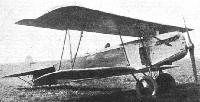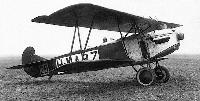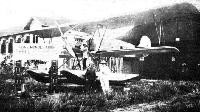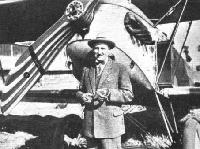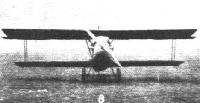
Fokker C.IV
В период, когда продажи военных самолетов на мировом рынке заметно снизились, Fokker C.IV имел некоторый коммерческий успех. Первый самолет поднялся в воздух в 1923 году, а его серийные поставки начались в 1924 году. Разработанный на базе модели C.I, он имел несколько большие размеры и более прочную конструкцию. Самолет оснащался двигателем Napier Lion и имел два втягивающихся боковых радиатора, установленных в носовой части фюзеляжа. По сравнению с самолетом C.I, фюзеляж и шасси с единой осью колес у новой машины были шире. Авиакорпус голландской Армии (LVA) приобрел 30 самолетов, а еще 10 купили вооруженные силы Голландской Ост-Индии (LA).
Всего были выпущены 159 самолетов C.IV, из которых 20 были по лицензии построены в Испании компанией "Jorge Loring". Испанские C.IV воевали в составе контингента в Марокко. Среди других заказчиков был СССР, закупивший 55 самолетов, а также Аргентина и авиаслужба Армии США. Один самолет проходил испытания в Италии.
Как и многие другие самолеты фирмы "Fokker", C.IV прославился своими надежностью и большим ресурсом. После эксплуатации в течение ряда лет в качестве разведывательных, эти машины в 1930-е годы с успехом использовались еще и как учебно-тренировочные в различных странах мира.
Варианты
C.IVa: вариант с уменьшенными размахом крыла и максимальной взлетной массой (2016 кг); самолет находился в эксплуатации в Голландской Ост-Индии (10 машин)
C.IVb: варианте двигателем Rolls-Royce Eagle мощностью 360 л. с. (268 кВт) или с двигателем American Liberty 12 мощностью 420 л.с. (313 кВт); несколько самолетов эксплуатировались авиакорпусом голландской Армии
C.IVc: дальний самолет-разведчик с размахом крыла 14,27 м; на нем был оставлен двигатель Napier Lion, несколько самолетов поступили в авиакорпус голландской Армии
C.IV-W: двухпоплавковый вариант гидросамолета с двигателем Lion и крылом увеличенного размаха от модели C.IVc; самолет C.IVH "Ciudad de Buenos Aires", пилотируемый аргентинским майором Занни, в 1924 году совершил перелет из Амстердама в Токио
CO-4: официальное обозначение варианта для авиакорпуса Армии США; три экспериментальных самолета XCO-4, а за ними пять самолетов CO-4A были оснащены двигателями Liberty 12А мощностью 420 л. с. (313 кВт), а модель CO-4A имела два боковых радиатора и фюзеляж, удлиненный на 0,24 м; самолеты проходили испытания на аэродроме в Мак-Кук Филд, штат Огайо
ТАКТИКО-ТЕХНИЧЕСКИЕ ХАРАКТЕРИСТИКИ
Fokker C.IV
Тип: двухместный самолет-разведчик
Силовая установка: один 12-цилиндровый ПД Napier Lion мощностью 450 л. с. (336 кВт)
Летные характеристики: максимальная скорость на оптимальной высоте 214 км/ч; практический потолок 5500 м; дальность 1200 км
Масса: пустого 1450 кг; максимальная взлетная 2270 кг
Размеры: размах крыла 12,90 м; длина 9,20 м; высота 3,40 м; площадь крыльев 39,20 м2
Вооружение: один или два 7,7-мм пулемета вверху передней части фюзеляжа и два 7,7-мм наводимых пулемета в задней кабине
Описание:
- Fokker C.IV
- Fokker DC.I
- Flight, August 1923
GOTHENBURG International Aero Exhibition 1923
Фотографии
-
Aeroplane Monthly 1999-10 / M.Oakey, T.Harmsworth - News
Регистрационный номер: N439FK [9] Unique Fokker C.IV N439FK airborne at the Owl’s Head Transportation Museum on July 18, 1999.
-
Aeroplane Monthly 2000-01 / G.Auliard - Old Dutch /Rare bird/
Регистрационный номер: N439FK [9] Another fine air-to-air shot of the C.IV over Owls Head. The characteristic Fokker construction methods, with thick-section ply-skinned wings, obviates the need for bracing wires and makes the aircraft surprisingly “slippery”.
-
Aeroplane Monthly 2000-01 / G.Auliard - Old Dutch /Rare bird/
Регистрационный номер: N439FK [9] N439FK over the Maine coastline on August 28, 1999. What a superb subject this would make for a flying model - hence the scale drawing we have provided on the facing page.
-
Air Enthusiast 2003-03 / G.Auliard - Maine attraction
Регистрационный номер: N439FK [9] Fokker C.IV N439FK.
-
Aeroplane Monthly 2000-01 / G.Auliard - Old Dutch /Rare bird/
Регистрационный номер: N439FK [9] Sole airworthy Fokker C.IV N439FK (c/n 4127) over Owls Head, Maine, USA on August 28, 1999. The aircraft’s saviour, chief restorer and test pilot Ken Cianchette donated it to the Owls Head Transportation museum in 1992.
-
Aeroplane Monthly 2000-01 / G.Auliard - Old Dutch /Rare bird/
Регистрационный номер: N439FK [9] Vibrantly painted in its 1930 colours and markings, the restored N439FK carries Wark and Brown’s optimistic “Tacoma to Tokyo” legend on its fuselage. After several attempts to reach Japan, none of which got beyond the shores of North America, they abandoned the aircraft to the elements.
-
Aeroplane Monthly 2000-01 / G.Auliard - Old Dutch /Rare bird/
Регистрационный номер: N439FK [9] A ground-crew member lends scale to the C.IV - that propeller has a diameter of 10ft 6in.
-
Aeroplane Monthly 2000-01 / G.Auliard - Old Dutch /Rare bird/
Регистрационный номер: N439FK [9] The bullnosed cowling conceals a Rolls-Royce Eagle VIII engine - the world’s only airworthy example of this powerplant.
-
Aeroplane Monthly 1998-10 / M.Oakey, T.Harmsworth - Vintage news
Регистрационный номер: N439 Fokker C.IV N439, newly restored in Maine, has been undergoing pre-flight engine runs.
-
Flight 1923-08 / Flight
The Fokker C.IV: Three-quarter rear view.
-
Авиация и Время 2013-06 / С.Ковалев - Авиация в Одесских маневрах 1927 года
Участниками Одесских маневров стали приобретенные в Голландии самолеты Фоккер С.IV и D.XI
-
Flight 1923-08 / Flight
The Fokker C.IV: Three-quarter front view.
-
Мировая Авиация 135
Регистрационный номер: H-NABZ Созданный на базе C.IV, истребитель-разведчик DC.I представлял собой одностоечный биплан смешанной конструкции с обшивкой из фанеры и полотна.
New Altitude Record: This Fokker Biplane, with Napier "Lion" engine, has reached a height of 6,470 metres (21,227 ft.) recently in the Argentine. The previous record for a machine carrying useful load of 500 kg. was 5,992 m. -
Мировая Авиация 134
Аргентинский летчик майор Занни предпринял в 1924 году попытку совершить кругосветный перелет на самолете Fokker C.IVH, он вылетел из Амстердама 26 июня, но 11 октября его полет был прекращен - он долетел только до Токио.
-
Flight 1924-08 / Flight
Just before the Start: Our picture shows Major Zanni and his engineer, Mr. Beltrame, while between them is Mijnheer Anthony Fokker, the designer of the machine. It is of interest to note that for the world-flight an Argentine pilot flying a Dutch machine should have chosen a British Napier "Lion" engine.
-
Flight 1924-07 / Flight
ANOTHER ROUND-THE-WORLD FLIGHT? Major Pedro Zanni, of the Argentine Air Service, with his Fokker biplanes (450 h.p. Napier "Lion") who is attempting an aerial round-the-world dash, starting and finishing at Amsterdam. He will be accompanied by Lieut. Nelson Page and Chief Engineer Beltrame, both of the Argentine Air Service.
-
Aeroplane Monthly 2000-01 / G.Auliard - Old Dutch /Rare bird/
Robert B. Wark and Edward Brown acquired the C.IV in August 1930 with a view to attempting a nonstop Seattle-Tokyo record flight in it.
-
Flight 1924-11 / Flight
MAJOR ZANNI'S WORLD FLIGHT: The above photograph shows Major Zanni's Fokker-Napier arriving at Hinandi, Iraq. The Argentine airman has got as far as Tokio, but owing to the lateness of the season he has decided to abandon the flight. Major Zanni has taken 19 flying days for his Amsterdam-Tokio flight - one day less than Pelletier d'Oisy's Paris-Tokio flight. The first 7,500 miles (Amsterdam-Hanoi) was accomplished in 17 flying days and with one Napier "Lion." Then the machine stuck in the mud and was crashed. The rest of the journey was completed on a new Fokker-Napier. Major Zanni, in a cable from Tokio, says :- "Very delighted state two Napier engines worked admirably until now without slightest indication trouble wear, and without any necessity change or touch parts."
-
Flight 1924-11 / Flight
Maj. Zani's World Flight: Maj. Zani, the Argentine airman, who has been attempting a round-the-world flight on a Fokker biplane fitted with a Napier "Lion" engine, has, after reaching Tokio, postponed the flight owing to the lateness of the season. The annexed photograph shows the seaplane model, at Haiphong, being refuelled with "Shell," which Maj. Zani said he "considered to be the best which I have ever used throughout the whole of my career as an aviator. By its unvarying quality it permits one to obtain from the engine the maximum power without imposing any strain."
-
Flight 1925-07 / Flight
Mr. B. Stephan, general manager of the Fokker works, standing by a Fokker biplane with Napier "Lion" engine.
-
Flight 1926-02 / Flight
IN THE FAR EAST: A Napier-engined Fokker, D.C1, flying over the rice fields of Java.
-
Flight 1925-03 / Flight
Fokker CO-4
-
Flight 1925-07 / Flight
A batch of Fokker machines with Napier "Lion" engines in the Fokker factory at Amsterdam.
-
Air Enthusiast 1997-03 / B.van der Klaauw - Fokker's American Heydays
One of the five CO-4As supplied to the USAAC. A striking difference is the modified engine cowling.
-
Aeroplane Monthly 2000-01 / G.Auliard - Old Dutch /Rare bird/
This view of the instrument panel area, taken before the welded steel-tube fuselage was covered, shows the aircraft’s complement of wonderfully “antique” control switches and levers.
-
Aeroplane Monthly 2000-01 / G.Auliard - Old Dutch /Rare bird/
Регистрационный номер: N439FK [9] Creature comforts: the Fokker’s cabin has been restored to its transport configuration, complete with metal-framed wicker seats.
-
Flight 1923-08 / Flight
FOKKER AT GOTHENBURG: On the left, a portion of the new Fokker undercarriage, in which the axle is free to travel laterally to a certain extent. This feature is stated to effect a great saving of tyres. In the centre the gunner's seat in the Fokker C.IV. The seat can be shifted fore and aft on the longitudinal tubes, and by reversing it, as shown by dotted lines, the seat is lowered so as to bring the gunner's head below deck. On the right is shown the mounting of the radiator, which can be withdrawn entirely into the fuselage.
- Фотографии











